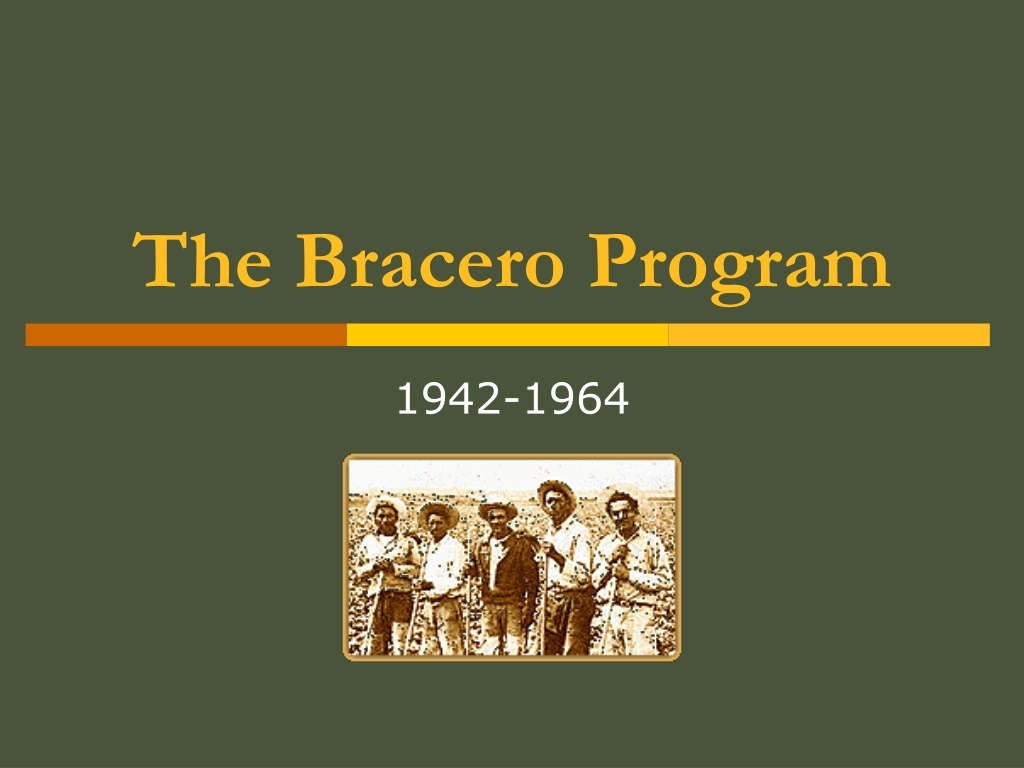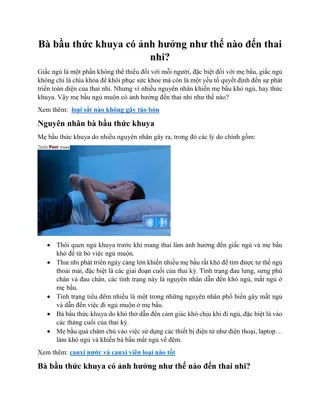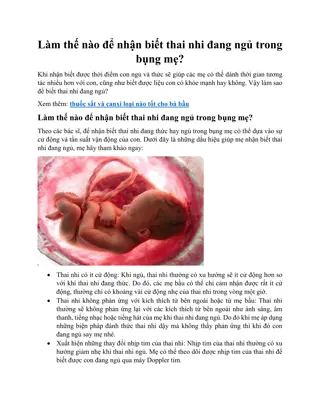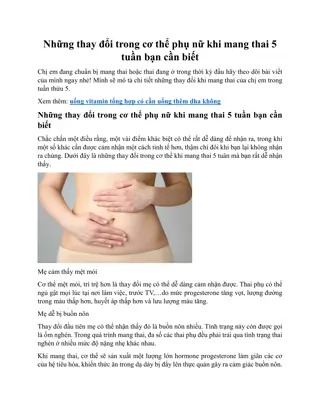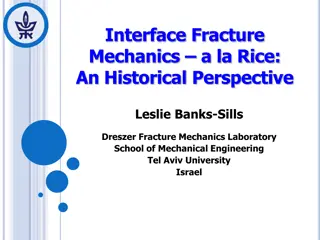Understanding the Bracero Program: A Historical Perspective
Foreign contract labor program, the Bracero Program, was initiated in 1942 during WWII between the US and Mexican governments, bringing 4.6 million workers to the US between 1942 and 1964. The program addressed labor shortages but also led to exploitation and mistreatment of Mexican migrant workers. The background of the program in both the US and Mexico sheds light on the socio-economic factors that influenced its initiation and eventual termination.
Download Presentation

Please find below an Image/Link to download the presentation.
The content on the website is provided AS IS for your information and personal use only. It may not be sold, licensed, or shared on other websites without obtaining consent from the author. Download presentation by click this link. If you encounter any issues during the download, it is possible that the publisher has removed the file from their server.
E N D
Presentation Transcript
The Bracero Program 1942-1964
What was the Bracero Program? Foreign contract labor program initiated in 1942 during WWII Also known as the Migrant Labor Agreement between U.S. & Mexican governments 4.6 million workers between 1942 & 1964 WHY THEN? Parallels with other societal changes? Why did it begin? Why did it end?
What is a bracero? Bracero Migrant worker. Mexican laborer who sells the work of his arms (BRAZOS) in the fields of the United States. Similar to farmHAND or HANDyman
What is a bracero? Generally speaking, the Latin American migratory worker going into west Texas is regarded as a necessary evil, nothing more nor less than an unavoidable adjunct to the harvest season. Judging by the treatment that has been accorded him in that section of the state, one might assume that he is not a human being at all, but a species of farm implement that comes mysteriously and spontaneously into being coincident with the maturing of the cotton, that requires no upkeep or special consideration during the period of its usefulness, needs no protection from the elements, and when the crop has been harvested, vanishes into the limbo of forgotten things -until the next harvest season rolls around. He has no past, no future, only a brief and anonymous present. From Latin Americans in Texas, by Pauline R. Kibbe, The University of New Mexico Press, Albuquerque, 1948
BACKGROUND In the US: Large Mexican agricultural labor force from 1880s, especially in CA, TX, and southwest Transformation of agriculture in 1920s-1930s to larger bank-owned enterprises (beginning of the end for family farms) instead of year-round farmhands, labor became migrant Growers did not want to pay fair wages to citizens preferred low-wage undocumented workers Border Patrol established in 1924, and many Mexican workers deported during the Depression, creating shortages of agricultural workers & providing leverage to legal workers STRIKES!
BACKGROUND In Mexico: Many people fled northward from 1910 revolution 1930s agricultural crisis harvests were insufficient to support many farming communities Imagined possibility of earning relative riches in the US (even though wages were often lower in Texas than in Mexico)
WWII and the Bracero Treaty 1941-1942 growers claimed labor shortage & refused to raise wages and demanded importation of labor instead of organized citizen labor Contract labor had been outlawed since 1885 -- a little too much like slavery BUT
The Bracero Program is established On September 27, 1942, the first braceros were admitted in time for the sugar-beet harvest. Reasons : The increasingly difficult circumstances of the Mexican working class in the cities and rural communities in regards to the scarcity of nourishment; increasing price rates and other economic overturnings; and Mexican workers' hope of earning better wages in the United States than in Mexico..." HUNGER IN ONE PLACE DRIVES FOOD PRODUCTION IN ANOTHER
Workers in Mexico City hoping to be contracted to work in the US, 1942
RECRUITMENT CENTERS ** Notice anything about gender?
RECRUITMENT CENTERS DDT not just used on crops
Braceros received an Alien Laborer's Permit and signed a contract, usually for 9-12 months, at the end of which they had to turn in their permits and return to Mexico.
Bracero Program: Documentation Although the bracero treaty called for contracts to be written in Spanish, often they were in English, and the braceros did not understand what they were agreeing to.
Upon arrival Ranchers would pick up the braceros at the borders and transport them to the camps.
Bracero Program: Contracts Braceros were contracted to one employer only. Regardless of labor conditions, if they were caught outside the farms specified in their documents, they were subject to deportation.
Living Conditions Conditions were often very poor, with workers sleeping in crowded barracks.
Employers Underpayment was the most common complaint often employers made braceros sign blank receipts and paid them far less than the agreed-upon wage.
But what were the conditions like for the workers?
1954: OPERATION WETBACK According to [INS Commissioner] Swing, the alarming, ever-increasing, flood tide of undocumented migrants from Mexico constituted an actual invasion of the United States. Operation Wetback commenced in June 1954 with a direct attack upon the hordes of aliens facing us across the border Planes were used to locate wetbacks and to direct ground teams working in jeeps to discourage re-entry, many of those apprehended were moved far into the interior of Mexico by train and ship. Mae Ngai, Impossible Subjects (2004):155-156
1964: THE END Union leaders and others led outcry against abusive conditions (and undercutting of union wages) Increased mechanization of agriculture decreased demand for labor More liberal rights-focused politics in Washington (connections with other movements?)
